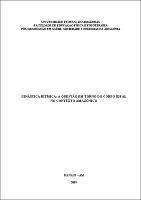| ???jsp.display-item.social.title??? |


|
Please use this identifier to cite or link to this item:
https://tede.ufam.edu.br/handle/tede/7560| ???metadata.dc.type???: | Dissertação |
| Title: | Ginástica rítmica: a questão em torno do corpo ideal no contexto amazônico |
| ???metadata.dc.creator???: | Santos, Kamila Pimentel dos  |
| ???metadata.dc.contributor.advisor1???: | Soares, Artemis de Araújo |
| ???metadata.dc.contributor.referee1???: | Nina, Afonso Celso Brandão |
| ???metadata.dc.contributor.referee2???: | Bortoleto, Marco Antônio Coelho |
| ???metadata.dc.description.resumo???: | O objetivo deste estudo foi analisar o desenvolvimento do fenômeno culto ao corpo e a aparência da imagem corporal das atletas de ginástica rítmica de competição em Manaus. Os motivos para essa busca fundamentam-se no fato de a Ginástica Rítmica (GR) exigir um modelo específico de estrutura de forma corporal com influência dos fatores socioculturais, representando um estereótipo magro, longilíneo e com baixa massa corporal. Esse corpo considerado ideal consequentemente leva as ginastas a terem uma grande preocupação com sua aparência corporal, o que muitas vezes influência no resultado da sua avaliação. Como instrumentos, utilizamos a escala ContourDrawing Rating Scale (CDRS), e o questionário de satisfação com a imagem corporal de Lutter (1999). As análises dos questionários obedeceram à metodologia recomendada pelos instrumentos, tendo como base uma escala de valores numéricos. Utilizamos a entrevista semiestruturada com os treinadores da modalidade, a fim de desvelar o olhar destes frente ao corpo considerado ideal para a ginasta, e existindo para eles um modelo ideal, verificar quais seriam as cobranças em relação ao corpo delas. Para análise dos dados da entrevista, utilizamo-nos de Bardin (2016). Os resultados apontaram um alto índice de insatisfação corporal pelas ginastas, entendendo-se que esses resultados são reflexos das exigências da modalidade que prioriza o padrão ideal como inegavelmente longilíneo magro e esguio, visto que o que está em jogo é um corpo essencialmente magro. Dessa forma, concluímos que muitas atletas procuram por uma estética corporal adequada e que as exigências da modalidade por um corpo magro levam a essa insatisfação, gerando outros desdobramentos, principalmente em relação ao corpo das atletas amazonenses. Desse modo, o corpo considerado ideal para a ginástica rítmica ainda é aquele que deve apresentar pernas maiores que o tronco, que não tenha músculos aparentes, e que deve possuir grande flexibilidade. Ao optar por esse esporte, assumem-se suas regras e as expectativas que elas pressupõem, e muitos estudos ainda podem ser explorados no contexto Amazônico. |
| Abstract: | The objective of this study was to analyze the development of the body worship phenomenon and the appearance of the body image of the athletes of rhythmic gymnastics of competition in Manaus. The reasons for this search are based on the fact that Rhythmic Gymnastics (RG) requires a specific model of body shape structure with influence of sociocultural factors, representing a lean stereotype, long-lined and with low body mass. This body considered ideal consequently leads gymnasts to have a great concern with their body appearance, which often influences the result of their evaluation. As instruments, we used the ContourDrawing Rating Scale (CDRS), and Lutter's body image satisfaction questionnaire (1999). The analysis of the questionnaires followed the methodology recommended by the instruments, based on a scale of numerical values. We used the semi-structured interview with the coaches of the modality, in order to unveil their look in front of the body considered ideal for the gymnast, and existing for them an ideal model, to verify what would be the charges in relation to their body. To analyze the interview data, we used Bardin (2016). The results showed a high rate of body dissatisfaction by gymnasts, understanding that these results are reflections of the requirements of the modality that prioritizes the ideal standard as undeniably slim and slender, since what is at stake is an essentially slim body. Thus, we conclude that many athletes seek for an adequate body aesthetics and that the demands of the modality for a lean body lead to this dissatisfaction, generating other developments, especially in relation to the body of Amazonian athletes. Thus, the body considered ideal for rhythmic gymnastics is still the one that must have legs larger than the trunk, that does not have apparent muscles, and that must have great flexibility. By opting for this sport, its rules and expectations are assumed, and many studies can still be explored in the Amazonian context. |
| Keywords: | Imagem corporal Ginástica rítmica |
| ???metadata.dc.subject.cnpq???: | CIÊNCIAS DA SAÚDE |
| ???metadata.dc.subject.user???: | Imagem corporal Atletas Ginástica rítmica |
| Language: | por |
| ???metadata.dc.publisher.country???: | Brasil |
| Publisher: | Universidade Federal do Amazonas |
| ???metadata.dc.publisher.initials???: | UFAM |
| ???metadata.dc.publisher.department???: | Faculdade de Educação Física e Fisioterapia |
| ???metadata.dc.publisher.program???: | Programa de Pós-graduação em Saúde, Sociedade e Endemias na Amazônia |
| Citation: | SANTOS, Kamila Pimentel dos. Ginástica Rítmica: a questão em torno do corpo ideal no Contexto Amazônico. 2019. 67 f. Dissertação (Mestrado em Saúde, Sociedade e Endemias na Amazônia) - Universidade Federal do Amazonas, Manaus, 2019. |
| ???metadata.dc.rights???: | Acesso Aberto |
| URI: | https://tede.ufam.edu.br/handle/tede/7560 |
| Issue Date: | 27-Sep-2019 |
| Appears in Collections: | Mestrado em Saúde, Sociedade e Endemias na Amazônia |
Files in This Item:
| File | Description | Size | Format | |
|---|---|---|---|---|
| Dissertação_KamilaSantos_PPGSSEA.pdf | 1.5 MB | Adobe PDF |  Download/Open Preview |
Items in DSpace are protected by copyright, with all rights reserved, unless otherwise indicated.




